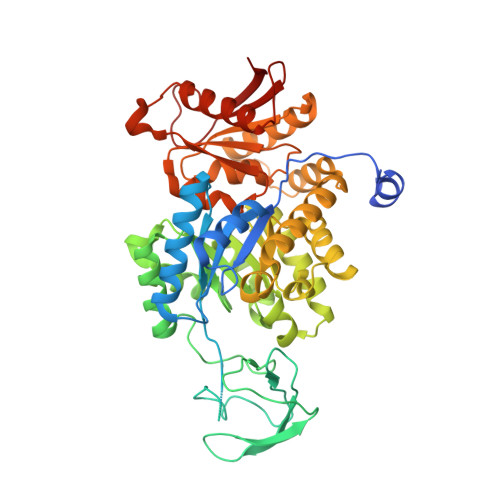Structures of pyruvate kinases display evolutionarily divergent allosteric strategies.
Morgan, H.P., Zhong, W., McNae, I.W., Michels, P.A., Fothergill-Gilmore, L.A., Walkinshaw, M.D.(2014) R Soc Open Sci 1: 140120-140120
- PubMed: 26064527
- DOI: https://doi.org/10.1098/rsos.140120
- Primary Citation of Related Structures:
4KRZ, 4KS0 - PubMed Abstract:
The transition between the inactive T-state (apoenzyme) and active R-state (effector bound enzyme) of Trypanosoma cruzi pyruvate kinase (PYK) is accompanied by a symmetrical 8° rigid body rocking motion of the A- and C-domain cores in each of the four subunits, coupled with the formation of additional salt bridges across two of the four subunit interfaces. These salt bridges provide increased tetramer stability correlated with an enhanced specificity constant (k cat/S 0.5). A detailed kinetic and structural comparison between the potential drug target PYKs from the pathogenic protists T. cruzi, T. brucei and Leishmania mexicana shows that their allosteric mechanism is conserved. By contrast, a structural comparison of trypanosomatid PYKs with the evolutionarily divergent PYKs of humans and of bacteria shows that they have adopted different allosteric strategies. The underlying principle in each case is to maximize (k cat/S 0.5) by stabilizing and rigidifying the tetramer in an active R-state conformation. However, bacterial and mammalian PYKs have evolved alternative ways of locking the tetramers together. In contrast to the divergent allosteric mechanisms, the PYK active sites are highly conserved across species. Selective disruption of the varied allosteric mechanisms may therefore provide a useful approach for the design of species-specific inhibitors.
Organizational Affiliation:
Centre for Translational and Chemical Biology, School of Biological Sciences , University of Edinburgh , Michael Swann Building, The King's Buildings, Mayfield Road, Edinburgh EH9 3JR, UK.


















